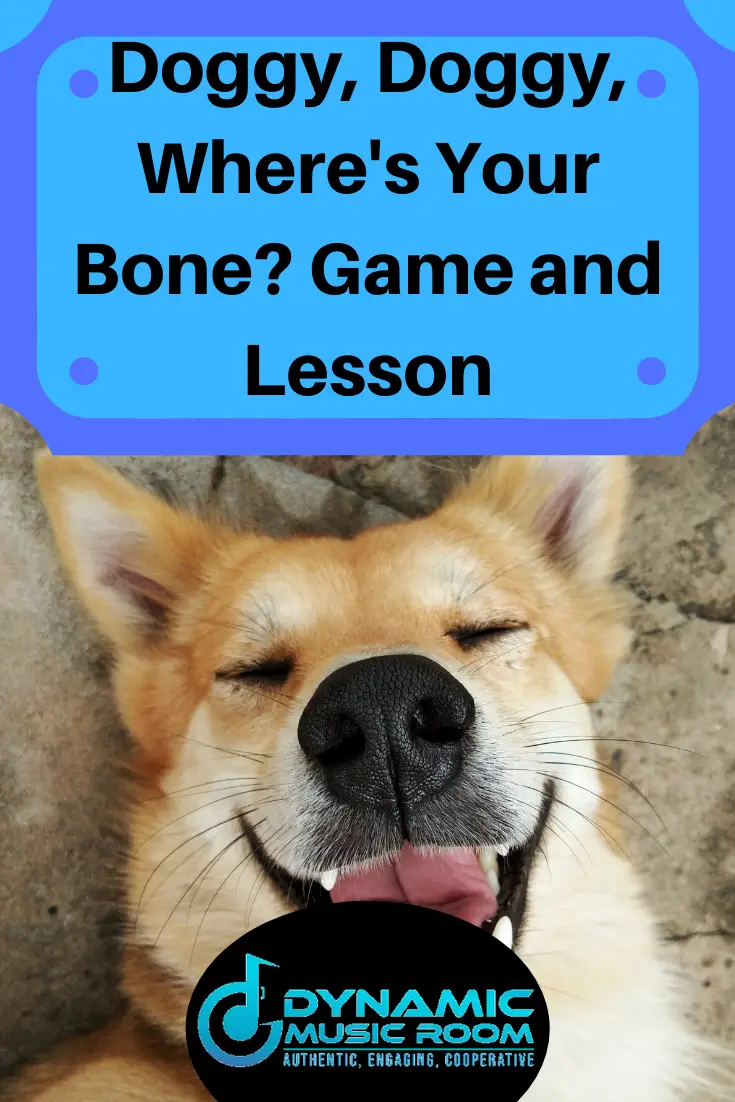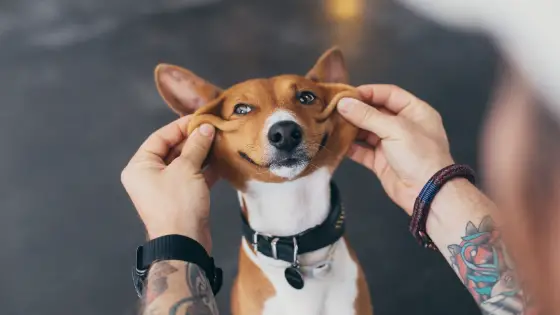Are you looking for a fun song for younger kids with a guessing game?
Do you want to reinforce taking turns in music and sol-la-mi?
Somehow, I completely missed this song growing up, and when first heard it in my college music classes, I didn’t give it much credit.
Once I started teaching, I introduced this song to my Kindergarten kids, and they loved it.
For fun music activities for younger grades, it doesn’t get much better than Doggy, Doggy, Where’s Your Bone?
The Doggie Doggie kids song is great for reinforcing independent singing, turn taking, and sol-la-mi patterns. The game is a simple guessing one which requires a couple of students to solo sing (sneakily, though!).
Read ahead for game directions, lyrics, and a sample lesson plan.
Table of Contents
Doggy, Doggy, Where’s Your Bone? Sheet Music Breakdown
I’ve done this song with First grade, but it seems to live most at home in Kindergarten or even Preschool/Young Fives.
Solfege: Do, mi, sol, la
Rhythms: paired eighth notes, quarter notes
Form: abac (sort of)
Lyrics:
Doggy, doggy, where’s your bone?
Someone took it from my home.
Who has the bone?
I have the bone.
Doggy, Doggy Where’s Your Bone Game Directions
The game is quite simple for this song. Students are seated in a circle with one student in the middle.
The student in the middle has their eyes closed.
The teacher or another student picks someone to hide the bone behind their back. I like to use a rhythm stick, but many teachers use a stuffed toy shaped like a bone or print off and laminate a bone to use.
All students (except the one in the middle) see who gets the bone. All students keep their hands behind their back.
The middle students keep their eyes closed.
- At the teacher’s cue, the class starts to sing. Everyone sings the first line, Doggy, doggy where’s your bone?
- The student in the middle sings the next line with eyes closed: Someone took it from my home.
- Everybody sings: Who has the bone?
- The student with the bone sings: I have the bone.
- The middle student opens their eyes and looks around. They have 1-3 guesses to guess who has their bone.
- Whether they guess correctly or not, the student with the bone becomes the new middle or doggie person, and the middle student gets to hand out the bone.
- The game repeats until all have had a turn.
Note: This is a sneaky way to get independent singers. This is a great time to assess the young student’s singing voice and offer private feedback later.
Doggie Doggie Song Lesson Idea
It’s possible to draw many types of lessons and learning from this song, but I like to focus on singing voice and simple form ideas with this one. The following is a sample lesson covering basic form ideas.
Students will need to be familiar with singing this song and playing the game before the “learning” of this lesson takes place.
Grade: Kindergarten
Concept: Form, Same vs. Different
Behavioral Objectives:
- Students will be able to take turns singing with the teacher and in different groups with 80% accuracy.
- Students will arrange the song into a different form using icons representing different sections with 80% accuracy.
Materials Needed: A set of different dog pictures consisting of 2 different pictures with two copies of each picture, the same sets in smaller manipulative form for groups of 2 or 4.
Assessment:
The teacher will take note of the small groups and assess based on how their performance matches the picture manipulatives given to them.
Procedure:
- Students and teachers play the song and game as described above.
- Teacher directs the attention of the students to the board and places the pictures there in ABAB order.
- Teacher sings A while asking the class to sing B.
- Class is split into 2 groups A and B. Sings the song again while pointing at the pictures.
- Teacher discusses through questions with the class which images are the same and different.
- Teacher changes the order of the pictures. Class sings in the same groups based on new form.
- Teacher defines form.
- Teacher explains group work procedures as per their preference.
- Class is split (by teacher) into groups of 2 or 4. Students (or teachers) decide who is A and who is B.
- Teacher hands out picture manipulatives and asks students to arrange a new form and perform the song in their small group with this form.
- Teacher monitors and offers feedback as the process goes.
- The teacher calls the class back to attention after checking each group.
- Materials are returned as the class hums the melody.
- Teacher asks students to explain the word, form, in their own words to those around them.
- The teacher calls on random students to share what they said.
Need help with lesson planning online? Check out MyLessonPlanner.
Affiliate links included, but I do use them!

Doggy, Doggy, Where’s Your Bone? Recorder
You may have noticed I also included recorder pitches in the Doggie, Doggie sheet music. This song is a fine one to teach on recorder, especially if the students played the song as a Kindergartener.
Don’t attempt this song on recorder unless the students are already very familiar with A, G, and low E pitches. This way they can focus on getting all their fingers down for low C.
It’s a great song for low C, and the independent singing we did in Kindergarten is also applicable as an independent recorder playing in 3rd-5th grade.
Here is a sample procedure for teaching this song on recorder:
- Have students tap/clap and say the rhythm.
- Students sing and sign the song in solfege.
- Students finger the first measure on the recorder while saying the pitches.
- Now students play the first measure.
- Students finger and say the pitches for the second measure.
- Play the second measure.
- Combine measures 1 and 2.
- Ask students if they notice any repeated sections.
- Finger and then play measure 3.
- Put 1, 2, and 3 together.
- Point out what students don’t know (low C), and show them the fingering.
- Echo just low C. Offer feedback throughout the whole process.
- Practice the last measure.
- Put it all together.
Conclusion
I hope you found this information on Doggy, Doggy, Where’s Your Bone? useful for your classroom.
I didn’t love this song at first, but when I saw the joy in my younger students’ faces as they sang, I knew it’d be a common part of my classroom.
Keep on singing!


